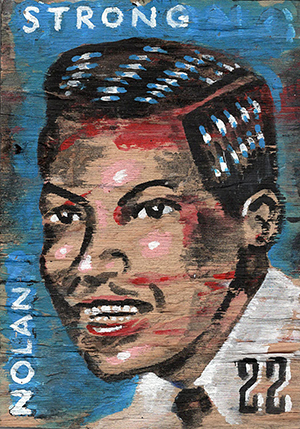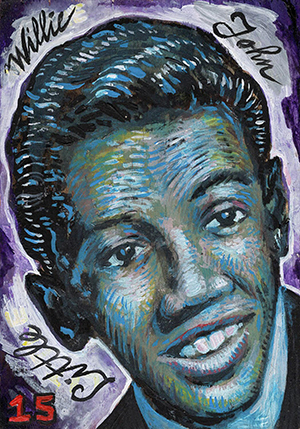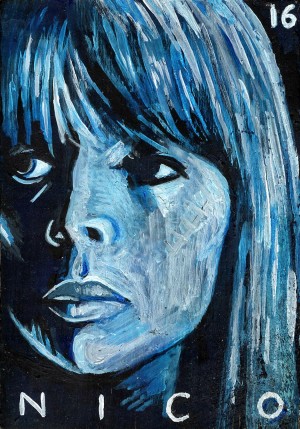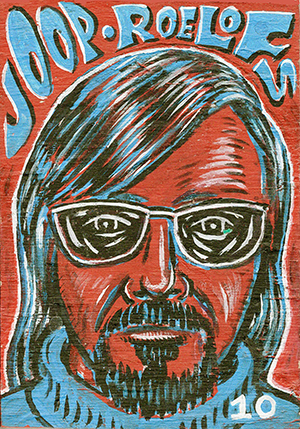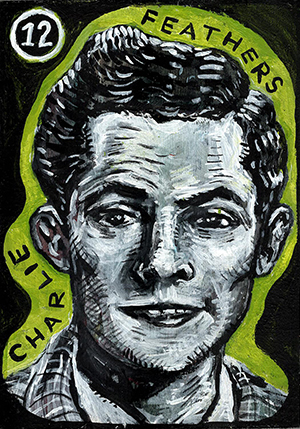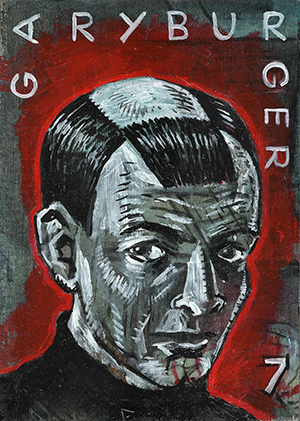-
Featured News
Patti Smith Upcoming Tour for 50th Anniversary of Horses
 By Harvey Kubernik
“Horses was like the first cannon blast in a war – frightening and disorienting. I mean, she was so unlike the FM radio terrain in every way. She was literate, aggress
By Harvey Kubernik
“Horses was like the first cannon blast in a war – frightening and disorienting. I mean, she was so unlike the FM radio terrain in every way. She was literate, aggress -
Featured Articles
BOB DYLAN: A Birthday Salute
 By Harvey Kubernik
May 24 is Bob Dylan’s birthday.
Bob Dylan’s ongoing influence is evident on the Bear Family Records’ 2024 compilation He Took us by Storm: 25 lost classics fr
By Harvey Kubernik
May 24 is Bob Dylan’s birthday.
Bob Dylan’s ongoing influence is evident on the Bear Family Records’ 2024 compilation He Took us by Storm: 25 lost classics fr -
BOB DYLAN: A Birthday Salute

By Harvey Kubernik
May 24 is Bob Dylan’s birthday.
Bob Dylan’s ongoing influence is evident on the Bear Family Records’ 2024 compilation He Took us by Storm: 25 lost classics from the Bob Dylan folk-rock revolution era. Dion, P.F. Sloan, Len Chandler, Donovan, Leon Russell, Dino Valenti, Lou Reed, Johnny Winter, David Crosby, Jackie Washington, Tom Rush, and Bobby Darin are heard.
Dylan’s 2025 tour concludes September 19 in East Troy, Wisconsin.
From 1975-2025 I’ve conducted interviews with people about Dylan:

Martin Lewis: The sixties actually began in Britain in January 1963. Just as the Beatles were starting to please, please us we drew our first breath of Bob Dylan. He appeared as the Greek chorus in an adventurous British TV play Madhouse on Castle Street. He sang “Blowin’ In the Wind.” It’s first broadcast anywhere in the world.
For this young English lad this was a heady time. “Please Please Me” made my head explode with the fizz of its joyously ascending climaxes. While Dylan’s anthemic “The Times They Are A-Changin’” lifted my soul. (As the late Ian Whitcomb remarked: Dylan was the world’s foremost “g-clipper”)
The sixties also ended in Britain. Six decade-long years later in August 1969 (Altamont that December was merely the burial). And just like its dawn, the twilight also featured Dylan and the Beatles. (Well, all except Paul). They all congregated on our Isle of Wight. Like Woodstock (two weeks earlier) but less hype and mud—more music. Dylan performed as the grand finale. It was his concert comeback after three years as the jester in a cast on the sidelines. The Marching Band’s John, George and Ringo communed backstage and in the VIP enclosure in front of the stage. (And, yes, this teenage Artful Dodger managed to bullshit his way briefly into that cloistered sanctum to bear witness. And to scoff some free nosh…)
Dylan flouted all the festival rules. Most people that season were wearing denim or tie-dye. Dylan wore a suit. A white one. Just like Lennon’s Abbey Road clobber. Some sets—The Who, Joe Cocker, Moody Blues—ran expansive lengths. Dylan’s set on the final night at 11pm was a tight, trim hour. But he crammed in hits and deep cuts. Mainly fresh interpretations.
It was the prelude to the Never-Ending-Tour and the Always-a-Changin’ arrangements. Fifteen songs. From “She Belongs to Me” through “The Mighty Quinn” (then a recent UK hit for Manfred Mann) in a brisk 60 minutes. Among the many highlights I recall a sublime “Lay Lady Lay.”
Some contemporary press reviews claimed the crowd of 150,000 felt short-changed by Dylan’s set. I don’t recall that as the collective mood. It felt like a benediction on the decade.
Incidentally, fourteen weeks later I was also witness to the exorcism of the decade – Lennon’s historic Plastic Ono Band concert at London’s Lyceum Ballroom. He played a searing “Cold Turkey” and then it was all over now baby blue… The sixties… the whole caboodle… The Dream Was Over.
Dylan’s sensibility left a huge mark on me. And when I eventually graduated from Artful Dodger to Artful Producer, I kept dipping into his songbook. I’m still dipping…
To paraphrase from the Dylan song, I produced with Pete Seeger (his last recording)—Dylan has kept my heart always joyful.
Bob: May you stay forever young…

Johnny Cash: I became aware of Bob Dylan when the Freewheelin’ album came out in 1963. I thought he was one of the best country singers I had ever heard. I always felt a lot in common with him. I knew a lot about him before we had ever met. I knew he had heard and listened to country music. I heard a lot of inflections from country artists I was familiar with.
I was in Las Vegas in ’63 and ’64 and wrote him a letter telling him how much I liked his work. I got a letter back and we developed a correspondence. We finally met at Newport in 1965. It was like we were two old friends. There was none of this standing back, trying to figure each other out. He’s unique and original. I keep lookin’ around as we pass the middle of the ‘70s and I don’t see anybody come close to Bob Dylan. I respect him. Dylan is a few years younger than I am but we share a bond that hasn’t diminished. I get inspiration from him.
We’ve gone fishin’ on my boat dock for hours and haven’t said a word.
Leonard Cohen: I came to New York City in 1966 and was unaware of what was going on at the time. I had never heard of Phil Ochs, Bob Dylan, Judy Collins or any of these people, and I was delighted, overwhelmed and surprised to discover this very frantic musical activity. Producer John Hammond was extremely hospitable and decent. He signed me to Columbia Records.
I liked the work Bob Johnston did with Dylan, and we became good friends. Without his support I don’t think I’d ever gain the courage to perform.
Patti Smith: The Bob Dylan Live 1966 Royal Albert Hall record. I can tell you this. I saw Bob Dylan in that period. I saw him right before he went to England (in 1966). I was really lucky. I saw him in 1963 when Joan Baez introduced him. I saw him through various changes. Then when he started wearing a jump suit, this lion-like hair and had a band, the Hawks, behind him. I saw him booed by the people even though he was really great. When I hear that record, I see him in my head because I can remember when he sang “Visions of Johanna” acoustically for the first time. He said, “This song is called ‘Seems Like a Freeze-Out.’” He didn’t have that title, you know. So, when I listen to that record it’s almost like a visual experience for me.
Brian Wilson: I was a fan of Bob Dylan in 1965. I like him. We did a song of his on the Beach Boys’ Party! I thought Dylan’s voice was an interesting voice.

Bob Dylan and the Byrds at Ciro’s. (Photo by Jim Dickson, courtesy of Henry Diltz, and Gary Strobl at the Diltz Archive)
Kim Fowley: Dylan was pioneering everything. So of course, he would be at the forefront because that’s his job to be first.
Dylan played the UCLA Folk Festival in 1963.
In 1965, Billy James invited me to a reception in Hollywood for Bob Dylan at Columbia Records. I said to Dylan, “What’s your gimmick? What’s your schtick?” And he replied, “Asking questions and telling stories.”
Then the following night, Bryan MacLean, a Byrds roadie before he was in Love, and I, were standing in front of Ciro’s. We knew there was a party in Hollywood at Ben Shapiro’s house who was Dylan’s booking agent. It was behind the Continental Hyatt House. We decided to crash it.
So, we jumped over a fence and climbed in through the kitchen window. I had a problem getting over the stove, and a pair of hands grabbed me across the stove-and it was Bob Dylan! And he grabbed Bryan and helped him through the window. He then asked if we wanted something to eat. “Sure, man!”
He wasn’t happy with the other people in the room at his party. “You guys wanna come? Hey, you’re that guy from yesterday! Have some chicken.” And he went and got us plates in the kitchen and fed both of us. He was very kind.
Then there was another party across the street. I was with Danny Hutton, later to form Three Dog Night. We followed Dylan’s entourage and ended up in a room at a hotel apartment. People then started harassing him. “Sing for us or we’ll kick your ass!” They were being mean. I felt bad for Bob Dylan.
So, I immediately jumped up and said, “Fuck all of you. I’m better than he is and I also sing better in his voice! So, you, Bob Dylan, play me Bob Dylan chords!”
On some level I got him off the hook. He said, “What do you wanna sing?” And I asked, “I dunno, what have you got?” Dylan said, “Sing something about walls.” Dylan picked up an acoustic guitar and I made up a song on the spot. The audience was shocked. They had no idea what to do. They didn’t want to applaud or fight. They were really confused.
Dylan encouraged me to be a solo recording artist. As Dylan was being whisked away by handlers, he offered some wine and said, “You’re as good as I am.”
Roy Silver was my manager in 1966, who in 1962 was the original co-manager of Bob Dylan with Albert Grossman.
I like Pat Garrett and Billy the Kid. The Dylan songs and the atmosphere. I like Bob on-screen. He has this charisma in the sense that he holds something back, and you want him to put out, and you anticipate, and he lets you see a little more. He teases you. The Charlie Chaplin mannerisms. You hear him and he stops singing, and you go ‘Wow.”

Bob Dylan and Rodney Bingenheimer (Courtesy of the Rodney Bingenheimer Archives)
Rodney Bingenheimer: I met Bob Dylan in 1965 at The Trip nightclub on the Sunset Strip in Hollywood. At the club I was with Billy Hinsche of Dino, Desi & Billy, who took a photo of Dylan and I holding my camera.
I went to the amazing December 1965 Bob Dylan concert at the Santa Monica Civic Auditorium. Marlon Brando sat in front of me. After the show, which was on my birthday, we all got up from our seats and went backstage. It was all happening! I love Cher singing Dylan’s “All I Really Want to Do.”
Andrew Solt: 1965 was the year my life changed. I graduated from Hollywood High School, started college at UCLA in February ‘65, and I discovered the Byrds at Ciro’s on the Sunset Strip. Ciro’s was two blocks from where I lived. Mecca! Dancing to the Byrds’ jet-powered rock at Ciro’s on Sunset Strip had me feeling like I was present at America’s version of the Cavern in Liverpool.
One day late that fall I heard on the AM radio, probably KFWB or KRLA, that Bob Dylan would be appearing one weekend at three L.A. area venues. My brother John and I bought tickets his concerts at the Santa Monica Civic Auditorium, the Long Beach Municipal Auditorium and the Pasadena Civic Auditorium.
The first set was acoustic. But when Dylan strutted out after intermission with the Hawks, the world seemed to stop spinning for a couple of hours. I was even more transfixed by Dylan live on stage with his electric guitar.
I was thrilled by his every move, his delivery and the way he cocked his head and sidled up to the microphone. His confidence and charisma were undeniable. He may have been an unlikely rock icon, but he definitely was one. It couldn’t have been any better. It was transformative. I was immersed in something groundbreaking that felt raw as vibrant as Dylan and his group were taking the audience and rock ‘n’ roll on a magic carpet ride to a whole new level. I didn’t want those nights to ever end. It was undoubtedly one of the most exciting weekends of my early life.
In May 1967 when Dont Look Back the D.A. Pennebaker documentary on Dylan’s UK tour in 1965 premiered in Los Angeles at an art house in Los Angeles, the Los Feliz Theater, I was there. Transfixed. Dylan on screen. Not stage. Docu verite window into a magical world-spellbinding moments, musical gems, beyond comprehension. Next day. Same place. Back in line for another shot.
Carlos Santana: FM radio in 1967 and ‘68. KMPX, KSAN. It blew my mind when I found it. Here’s the word: Consciousness revolution. It did not come from Liverpool or New York. I think it came from San Francisco. The psychedelic shock. Haight-Ashbury. When I first heard “Desolation Row,” it was like, “Man, this is like being inside one of Bob Dylan’s songs or something.”
For me, being right out of high school, and listening, really listening, it gave me a vast awareness of “where do I belong it all this?” And I looked at B.B. King on my left and Tito Puente on my right. The first time I saw Michael [Bloomfield] play guitar…it literally changed my life enough for me to say, “this is what I want to do for the rest of my life.”

December 1965. Santa Monica Civic Auditorium. Drummer Sandy Konikoff, Bob Dylan, Robbie Robertson (Photo by Rodney Bingenheimer.)
Mick Farren: The weight of anticipation that was loaded upon the release of John Wesley Harding was probably more than any artist should be expected shoulder. How in hell was Dylan going follow something as monumental as Blonde On Blonde? And in the landscape that I inhabited, not only were fans, musicians, writers, and rock critics asking the question. So were individuals who had regularly spent entire Sunday afternoons skulled to Neptune on the best obtainable acid listening to “Sad Eyed Lady of the Lowlands” over and over again, searching for some nebulous electric dharma of their own imagining. And when the answer turned out to be relaxed, controlled and even reserved, conflict broke out between those how just wanted more, just B-on-B 2, and others who were frankly baffled and studied the cover photo for mystic clues. Acidheads did not come to blows, but they glared at each other with their third eyes. Me? I accepted what I was given, and then I learned to love it. So, we had no more recklessly complex, declamatory monoliths like ‘Like A Rolling Stone.’
Dylan had constructed cottages; neat formal songs that smelled of Jerry Lee Lewis, Sam Phillips, Hank Williams and A.P. Carter. He had edited and simplified, and in so doing had created tunes that, down the years, proved to be of incredible durability. Think of all the songs from JWH, that are still covered, to the point that “All Along the Watchtower,” the song itself, can, in 2007, function as a crucial, cliffhanging, metaphysical, deep-space entity in the TV sci fi cult series Battlestar Galactica. I learned a long time ago, that with Ol’ Bob that the only answer to shrug. Go figure.
Greil Marcus: The first thing a friend said when we first heard the album John Wesley Harding on the radio, late one night on KSAN-FM, “I think we’ll be listening to this for a long time.”

Michael Simmons: I adored John Wesley Harding when it came out at the end of ’67. Still do. It’s one of my favorites among many Dylan favorites. There’s an account that I read years after the album was released that Dylan had a huge, well-thumbed Bible on a stand at his home in Woodstock. I remember thinking that’s where John Wesley Harding came from to some degree. It’s full of morality tales and parables and Book Of Revelations dread. One could argue that JWH is Dylan’s first biblical album. Also, Bob obviously knew that the album would be pored over by fans looking for ‘the truth’ and the liner notes are hysterically funny – a dig at First Decade Dylanologists. The country seduction tunes “Down Along the Cove” and “I’ll Be Your Baby Tonight” end the album and seamlessly lead into his next – Nashville Skyline.
Chrissie Hynde: Bob Dylan’s “Forever Young” has got such a beautiful lyric. I just love it. He’s the pride of our generation. The song is genius. I’ll tell you another great Dylan album, that was not one of his most popular ones, was Shot of Love. The song, “Lenny Bruce.”
Time Out of Mind. It’s one of his best albums. He just sings magnificently, for a start. They’re just great songs. Bob always writes impeccable songs, but my suspicion is that he’s a little impatient in the studio. On this one, he really stuck it out and got gorgeous vocals. The singing is fantastic. The songs are so well crafted and they just got the great sound for each song. You don’t feel like he just got a band in, wheeled them in and played all the songs and left. Each song is very carefully thought out.
Obviously, that’s a lot in the production and I’m sure that’s Danny Lanois who masterminded that. Jim Keltner is the perfect drummer for any band if you ask me. He’s great with Bob Dylan. Keltner is a genius drummer. I love that guy.
Clem Burke: Dylan was just being himself in Dont Look Back. The whole cinema verite concept. You got the feeling you were a fly on the wall and Pennebaker had access.
The Last Waltz was great. I went to see a screening of it at The New School when it first came out and Martin Scorsese and Robbie Robertson spoke at it.
That is getting back to what I thought music videos should be. There you have great performances captured for prosperity. You have a moment in time that should have been captured. All those artists together in one place. Levon Helm blew my mind.
I liked The Concert for Bangladesh, but no behind the scenes stuff at all just about performance.
Steven Van Zandt: I’ve gone through different phases with Bob Dylan. I had an older friend who first played me the folk music stuff of Bob the first three albums. I liked it but didn’t understand the whole poetry thing. I was age 12 and didn’t quite get it. He was interesting, even then.
As a guitar player, I’ve played Dylan’s songs with Bruce [Springsteen] and in top 40 bands earlier. Dylan was an extremely good folk guitarist as far as the folk style he played on his first few albums. Extremely adept at that.
The Byrds introducing him to the world, really, with “Mr. Tambourine Man,” was a major factor. I can’t give them enough credit for that. I don’t know if Bob Dylan would have been accepted at Top 40 radio if it hadn’t been for “Mr. Tambourine Man.” I mean that, Harvey. That gang has been a great service to the world. I was a huge Byrds’ freak. Still am. As you know, they lead you to Bob.
On my Little Steven’s Underground Garage and Outlaw Country [SiriusXM satellite radio] channels I program things from Johnston’s Cash albums all the time, especially the live San Quentin. I like to spotlight producers, whether it be Andrew Loog Oldham with the Rolling Stones, or Bob Johnston’s work with Dylan. These are people who need to be talked about.
I play a lot of Highway 61 Revisited and Blonde On Blonde. I talk a lot about [Michael] Bloomfield. Oh my God… One of the greats. The single most unsung guitar hero. Really, right there alongside the holy trinity of (Eric) Clapton, (Jeff) Beck and (Jimmy) Page. Probably next in line as far as influence and importance would be Mike Bloomfield in our early youth growing up. Extremely important.
We usually don’t play a lot of Bob’s things that classic rock stations are playing, like “Tangled Up In Blue.” I’ve programmed Rod Stewart and the Faces covering “The Wicked Messenger” from John Wesley Harding and Jimi Hendrix doing “All Along the Watchtower” from the same album.
Dylan pretty much walked away from rock ‘n’ roll for a minute, and started getting back to his roots and taking them to some other place, more the country and folk world where he came from. People didn’t know what to make of it at the time. It was a strange sort of new Bob Dylan that emerged after his July 1966 motorcycle accident.
Jimi Hendrix did more to promote John Wesley Harding than anybody. It was one of the most remarkable records ever made of course. And the fact that Jimi picked up on that from that unusual and not very popular Bob Dylan album and made everybody go back to it. And, I’m telling you Harvey, that’s how powerful that record was.
Everybody went back to John Wesley Harding after hearing Hendrix, thinking, “you know, maybe I missed something? Look what Jimi Hendrix did with it. Look what the Faces did with it.” It worked. It’s a terrific album but sort of subtle, compared to Blonde On Blonde that most people consider Bob’s peak.

Kenneth Kubernik: There is another American original, a musician whose body of work, scope of influence, and inscrutable personality mirrors so many of Bob Dylan’s most singular attributes. Pianist Keith Jarrett is not a name that leaps to mind when talkin’ ’bout Bob’s imperishable impact, that litany of artists long identified with his idiosyncratic approach to song craft, interpretive wanderlust, and rousing conviction.
There is nary a one that reeks of jazz. But Jarrett — revered by players and serious students of improvisation, reviled by the jazz constabulary for his irascible nature – has, since the ’60s, spun closely within Dylan’s musical orbit. When jazz was moving uncomfortably towards rock and funk, Jarrett had his trio perform “My Back Pages,” and “Lay Lady Lay,” coping a Floyd Cramer groove more redolent of Nashville’s skyline than Manhattan’s hot house revelries.
In an interview with England’s Melody Maker, Jarrett cited Dylan’s insight that artists “walk a razor’s edge,” when asked to describe the opaque process behind his mesmeric solo piano recitals. More than Monk and Miles, Trane and Bird, Jarrett found common cause with Dylan’s redoubtable independence of thought and action. It is amusingly apt that Dylan, in recent years, has turned to performing the American songbook – “standards” – that provide the beating heart of every educated jazz musician. He’s on Jarrett’s turf here and one can only imagine that aching croak nestled inside the pianist’s ineffable accompaniment. Wonder boys…”
Outside of maybe Bob Marley and Jimi Hendrix, no popular musician commands a more robust, enthusiastic international following than Dylan. His “voice” is heard in every language that speaks through music to celebrate the resiliency of the soul against the tides of a world gone wrong.
Heather Harris: You could be reading of personal discovery of the music of Bob Dylan contemporary to its creation so epiphanic to my preteen ears that I was left gasping for air like a fish out of water. Yes, he was that different from all others at the time and yes, he was that good. This was instantly perceptible even to naive prepubescent music fans like yours truly, gifted with new record albums by a caring older sibling already in college (shout out to my late brother Randall, who eventually owned and helmed a recording studio in Nashville.)
But this here article will contain far more efficient and far more lyrical treatments of the revelation that was the 1962 and beyond Bob Dylan by insightful oracles in our business that is music. My task is to remind you or even to introduce you to the rare visual talent behind him that was deemed worthy of portraying this spankin’ new icon to not only his new generation of peers, but to be sufficiently universal enough to stand the test of history right along with this music’s maker.
Fortunately, his visual legacy boasts some the last century’s best still photography artists ever to grace the medium. Dylan immediately attracted the best of the best, even beyond the promotional efforts of his hard workin’ manager Albert Grossman.
We are lucky to have the portraiture and live stage photography works of Dylan by: (debatably the entire 20th century’s very best photographer) Richard Avedon; 1960s’ white hot chronicler, future film director Jerry Schatzberg; Jim Marshall (of way too many instantly recognizable iconic shots to list; Bob Gruen who documented Dylan from his uproarious 1965 Newport Festival electric revolution and continued to do so into our 21st Century so he is happily still here to shoot and recount the tales; Daniel Kramer (album covers of both Bringing It All Back Home and Highway 61 Revisited plus some engaging Dylan books of same); Don Hunstein (the immortal, oh so evocative The Freewheelin’ Bob Dylan cover with the Village’s cutest activist couple Bob and close personal friend Suze Rotolo); and David Gahr (my only personal photography hero along with Kurt Ingham) alongside Milton Glaser (my only personal graphic art hero along with John Van Hamersveld) who designed that amazing polychrome psychedelic drawing of Dylan along the way to his I Heart NY sloganeering, in the graphics included inside the first great compilation of Dylan songs from Columbia, a poster which resided in probably three quarters of all college dormitories of the era.
Most media-savvy music enthusiasts will recognize the names in this list, with the possible exception of Rolling Stone and Creem magazine covers’ photographer (and later punk singer known as Mr. Twister who covered Highway 61 Revisited with particular elan in the gory bits) Kurt Ingham and David Gahr.
To write of the former, my late husband, might be inexcusable nepotism here so I will concern us with the often feloniously overlooked David Gahr. Peruse the book The Face of Folk Music, photographs by David Gahr, text by Robert Shelton, 1968. It contains the best/greatest/most exciting/most flattering black and white pics ever taken of each of the performers. Granted, Gahr’s own definition of “folk music” remained sufficiently elastic to have included Frank Zappa and the Mothers of Invention, Janis Joplin & Big Brother and the Holding Company, or any number of rockers Gahr was hired to document live, on location or in the studio.
His C.V. was whomever represented the pinnacle in modern music or soon would be. The US postage stamp featuring Miles Davis arched in an extreme but naturalistic pose wailing on horn was David Gahr’s portrait. And of course, gobs of timeless pics of a then young Bob Dylan. Because of his body of work in this very book I am a self-taught photographer. It instantaneously taught me, (not his words) the following: Flatter the subject even while extracting all the excitement possible in action gestures. Shooting natural light onstage is always superior to flash (when possible.) Make sure your timing is impeccable, no microphones covering most of the face. Document what’s there without editorializing: your own P.O.V. can be deceptively candid, as will be the subject’s. Trust your fine art background (which I had) to get unusual but perfect composition. Make sure your photos are the right value/balance/contrast to reproduce exactly as you expect. (I’ve seen Gahr’s photos in person: they look precisely as they appeared printed in books or other media.)
“If your memory serves you well…” None of us or any other recording artist or any human for that matter has ever equaled the torrential talent of Bob Dylan’s wordsmithery.
As someone who came of age in the 1960s, I was inexplicably proud when he wrote and released his Murder Most Foul in recent-ish 2020, proving to generations subsequent to his own that there still was stainless steel strength to his observations about modern history, with not a whit of loss of superconductor creativity even in an eleven- minute epic song.
Furthermore, the accomplishment of James Mangold, Jay Cocks and Timothee Chalamet in A Complete Unknown, underscores and presents context to current and future generations about why this artist was and is so revered. It’s a smart, well-cast, high caliber biofilm that not only doesn’t insult its subjects but also is worthy of them. Their memory does serve them all well.
© 2025 Harvey Kubernik
Johnny Cash Show TV Guide ad, Dylan ad with LP covers, Isle of Wight ad courtesy of Gary Pig Gold.
Bob Dylan concert ticket courtesy of Kenneth Kubernik
Lotti Golden’s Motor-Cycle Reissued by High Moon Records
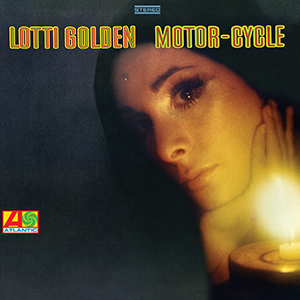
By Harvey Kubernik
I remember in late 1969 when an acquaintance of mine, Heather Harris, an editor at the UCLA Daily Bruin Entertainment pages, received a copy of the Bob Crewe-produced Lotti Golden debut LP Motor-Cycle on Atlantic Records.
Harris, and another concert pal of mine, Nancy Rose Retchin at Palisades High School, were big fans of Laura Nyro, and both knew I liked female singers and poets.
In winter of 1969 I first heard Golden’s Motor-Cycle on KPPC-FM in Pasadena, California, and got my own copy of the album at Wallichs Music City in Hollywood. I had read reviews of her in Newsweek and The New York Times when I stocked shelves in the library at West Los Angeles Junior College in Culver City.
Golden’s stream of consciousness lyrics was influenced by the beat generation and Jack Kerouac. Motor-Cycle wasn’t Brill Building pop music, but songs about narcotics, gender identity, the ramifications of involvement, and urban alienation from a Thrill Building tunesmith who was the landlord doing the reporting.
In 1968 and ’69, Heather, Nancy and I went monthly to the Shrine Exposition Hall in downtown Los Angeles for the Pinnacle Dance Concerts. Three former USC students, Sepp Donahower, Mark Chase and John Van Hamersveld, promoted 13 shows of visiting acts and local bands. It was where art, film and music collided. Filmmaker George Lucas was on the Single Wing Turquoise Bird lightshow crew. We saw Moby Grape, Canned Heat, Buffalo Springfield, Jefferson Airplane, Vanilla Fudge, Pogo (pre-Poco), Lee Michaels, Mothers of Invention, Richie Havens, and Sweetwater.
BIRTHDAY BAMA LAMA: A Calendar of 365 Musical Mugshots by Olaf Jens

By Mike Stax
Dutch-born California resident Olaf Jens is one of my favorite living artists. Inspired by great comic book illustrators like Will Eisner and Robert Crumb and the New Objectivity artists of the 1920s like Otto Dix and Max Beckmann, his work is executed with skill, imagination and an all-too-rare flair for character and atmosphere. His artwork can be seen on an array of record covers released over the past decade or so including the Twisted Tales from the Vinyl Wasteland series, Back from the Grave Volumes 9 and 10, and releases by the Jackets, the Chrome Cranks, the Kentucky Colonels, the Legendary Stardust Cowboy, and more. He’s also responsible for the fabulous banner for our “Echoes from the Vault” reviews section in Ugly Things.
Olaf’s character portraits of his favorite musicians from the world of rock ‘n’ roll, R&B, punk, garage, country music and more are especially well-rendered. He recently produced an eye-popping calendar with an incredible 365 color illustrations, each assigned to their date of birth—from country singer Ernie Chaffin on January 1 through Egyptian vocalist/actress Oum Kalthoun on December 31.
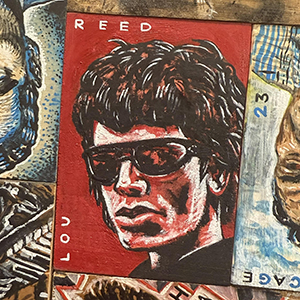
Famous names like Dolly Parton, Little Richard, Gene Vincent, Don Everly, Tina Turner, Bo Diddley, Lou Reed, Roy Oribson and Iggy Pop, are featured alongside lesser-known cult figures like Cathy Berberian, Adrian Lloyd and Robert Drasnin. There’s ‘60s garage icons like Sky Saxon, Gerry Roslie, Question Mark, Moulty, and Sam the Sham; UK ‘60s heroes like Syd Barrett, Chris Britton, Dave Davies, Screaming Lord Sutch, and Sharon Tandy; blues and R&B artists like Jimmy Reed, Elmore James, Slim Harpo, Ruth Brown, Nathaniel Mayer, Howlin’ Wolf, and Charlie Patton; rockabilly cats Johnny Burnette, Gene Summers, The Phantom, Charlie Feathers, and Cliff Gallup; country singers like Loretta Lynn, Porter Wagoner, and Red Sovine; legendary producers like Sam Phillips, Joe Meek, and Sir Coxsone Dodd; a plethora of punk rock and post-punk characters including Jean-Jacques Burnel, Mark E Smith, Rat Scabies, Joey Ramone, Poly Styrene, Richard Hell, Lux Interior, Ed Kuepper, and Johnny Strike; neo-garage rock mavericks like Billy Childish, Russell Quan, Holly Golightly, Jon Spencer, Johnny Bartlett, King Khan, Fink, and Monoman; and outliers like Sun Ra, Eric Satie, Harry Smith, Chopin, Nico, Jack Kerouac, Korla Pandit, Criswell, Brigitte Bardot, Omar Korshid, and Anton LaVey. Scattered among them all are a host of upper echelon Ugly Things heroes including Phil May, Viv Prince, Wally Tax, Joop Roelofs, Arthur Lee, Cyril Jordan, Gary Burger, and Gabor Szabo.

Each portrait was painted with acrylic on 3.5” x 5” wooden panels, most of which were quickly snapped up by collectors and fans. But if you want every last one of them, you can hang this beautifully-presented collection of 365 on your wall instead.
For more details, email olaf.jens@g
mail.com
